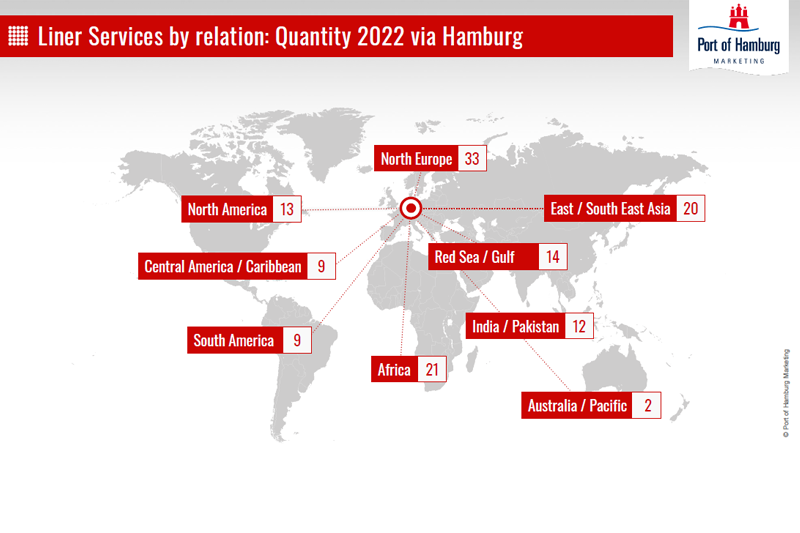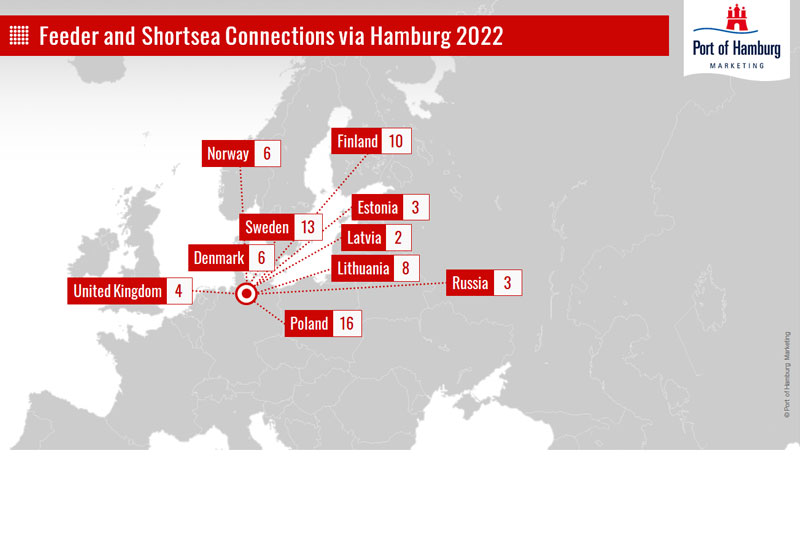“Ever Alot“
The “Ever Alot“ is the first container ship with a slot capacity of over 24,000 TEU.
The Port of Hamburg has one of the most tightly woven service networks in Europe: around 100 liner services connect the Hanseatic city with many of the world's seaports. Other ports can be served via transhipments. In addition Hamburg as a sea port fulfils a role as an important hub for distributing feeder cargo in the North Sea and Baltic Sea regions.
About 8000 ocean-going ships arrive in the Port of Hamburg every year. The Asia trades are one of the main markets: In 2022 an average of 20 full-container Asia services called in Hamburg every week. In addition 33 liner services Nord Europe, 21 to Africa, 14 to Red Sea / Golf, 9 to South America, 13 bound for Northamerica and nine to Middle America as well as various direct connections with other trade routes, e.g. India/Pakistan, Central America/Caribbean and Australia/Pacific.
Hamburg sees continuous growth in the number of calls by containerships with a capacity of 10,000 TEU and more, the ultra-large containerships (ULCS). In 2022 468 ULCSs tied up in Hamburg. Terminal operators have long since adapted to this trend and extended their facilities accordingly.

Very large ships deployed in intercontinental deep sea services usually only call in ports able to offer adequate cargo volumes. Ports generating limited cargo volumes or those away from the main routes are usually served by feeders. Smaller containerships are used for these that are suitable for the respective trades with capacities of between 300 and 1,800 TEU.
Important European trades that are mostly served by feeder ships are the North Sea and the Baltic region. Hamburg is the major North-European transhipment hub for these services. In addition to distribution services intra-European cargo is frequently transported via the Port of Hamburg en route to the North Sea and the Baltic region (short sea shipping). Weekly, numerous feeder and short sea services connect Hamburg to Scandinavia, Poland, Finland, Russia and the Baltic States as well as to Great Britain, Ireland and Iceland. Hamburg takes on an important role in exports from Germany and our European neighbours.
Because of its position at the mouth of the Kiel Canal Hamburg is known as the most westerly Baltic Sea port. The Kiel Canal is a considerable location advantage for the Port of Hamburg and the German seaports on the North Sea, which are in competition with the ports lying further west. Hamburg has an advantage in the length of the route, e.g. using the Kiel Canal to Gdansk in Poland is 437 sea miles as opposed to 874 around the northern tip of Denmark (Skagen).
